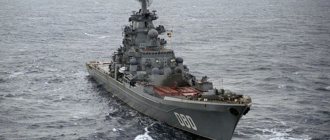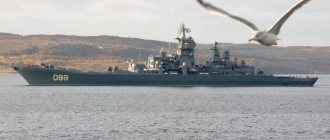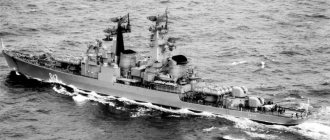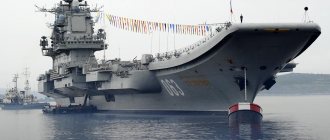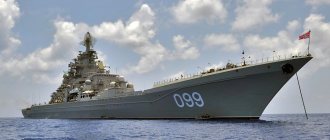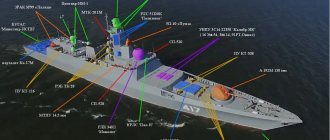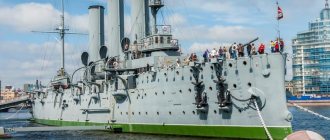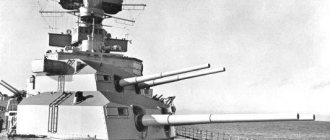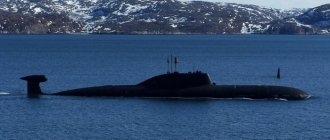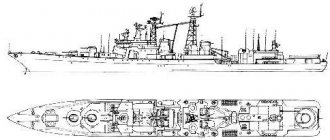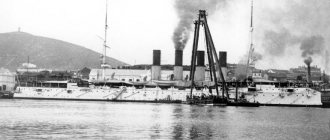Missile cruisers are a fairly new type of ship that grew not from classic cruisers with a rich biography, but have formed a separate direction in global shipbuilding based on destroyers. A special place in their development was occupied by the subclass of nuclear warships.
And since they were created to wage nuclear missile war, they did not have traditional constructive protection. And part of the displacement intended for carrying heavy armor was absorbed by more and more new types of weapons with their changed volumes and energy consumption, as well as crew accommodations, for which the requirements also changed, especially on ships intended for long-term autonomous navigation.
Project "Orlan"
The project was based on the premise of creating an ocean-going ship of unlimited autonomy, which was supposed to search in the vastness of the World Ocean and then destroy nuclear submarines.
The Leningrad Northern Design Bureau received technical specifications for the development of a new project, which was named “Orlan” and numbered 1144. The project provided for a local scheme for protecting the most important types of weapons from the effects of a missile strike. Therefore, most of the weapons were hidden below deck.
The main enemy of the new ship was supposed to be powerful enemy aircraft. And to combat it, air defense systems of different operating principles and calibers were introduced into the armament. Anti-ship missiles were designed to combat aircraft carriers.
Project 1144 was very extended in time, supplemented and reworked. The appearance of a multi-purpose warship was emerging more and more clearly. At one stage, the future ship received its final classification; it became a heavy nuclear-powered missile cruiser.
The ships of the Orlan project (abroad it received the designation Kirov-class battlecruiser after the name of the first TARK) have no analogues abroad. The cruiser's total displacement is almost 26 thousand tons, while even the non-serial nuclear-powered missile cruiser Long Beach of the US Navy is one and a half times smaller.
The government of the Soviet Union decided to build four warships of this class.
After the laying of the first cruiser, the project was finalized, and the next three cruisers were built according to Project 11442. All ships differ in the types and number of weapons. It was assumed that all ships would be equipped according to the new design, but not all types of weapons were put into mass production and were added as they were ready. Therefore, only the last cruiser corresponds to the project almost completely.
Admirals of sad fate: Russia is losing great ships
The Russian military has signed a contract for the dismantling of the heavy nuclear-powered missile cruiser Admiral Lazarev. Russia is conducting serial construction of ships in the far sea zone. But will they be able to become a worthy replacement for the dismantled nuclear cruisers of the USSR?
The contract for cutting up the ship was awarded to the 30th ship repair plant in Primorye and the Rosatom corporation. By August of this year, the contractor must assemble a cutting slipway, near which the cruiser will spend the last years of its life. Disposal will be completed in 2025 and will cost the state five billion rubles.
In fact, a fundamental decision about the fate of the cruiser was made back in 2018. A source in the Ministry of Defense reported then about a package decision to dismantle six nuclear cruisers and submarines. Among those “sentenced” were two representatives of Project 1144 “Orlan”: the cruisers “Admiral Ushakov” and “Admiral Lazarev”.
Then the situation hung in the air for a while. On the one hand, breaking is not building; on the other hand, the ships that were too unique were supposed to be scrapped.
Giants of the Cold War
The Project 1144 Orlan cruisers were designed and built at the end of the USSR and relied on the full power of the then science and industry. Their construction started in 1973, and the last of the giants was completed after the collapse of the country, in 1996. Of the planned seven, four ships were built: Admiral Ushakov (Kirov when laid down), Admiral Lazarev (Frunze), Admiral Nakhimov (Kalinin) and Peter the Great (Kuibyshev). .
As a result, the Soviet and then the Russian fleet received the largest (after American aircraft carriers) and heavily armed surface ships in the world. NATO experts even introduced the special term Kirov-class battlecruiser, which translates as “Kirov class battle cruiser.” After the start of service, these ships were classified as “game-changing weapons,” that is, fundamentally affecting the balance of power in the region where they appeared. And no wonder: the main caliber of each Orlan is 20 Granit anti-ship missiles, which provide over-the-horizon destruction of enemy naval groups with nuclear weapons. At extremely long firing ranges, these missiles are aimed using Tu-95 strategic bombers or satellites.
The ships' air defense also inspired respect and awe in the potential enemy: the basis of the air shield was the naval version of the S-300 anti-aircraft missile systems, the most advanced versions of which made it possible not only to splash down aerodynamic targets (airplanes, helicopters, cruise missiles), but also to shoot short-range ballistic missiles actions. Long-range air defense on the first three cruisers was supplemented by a naval analogue of the military air defense system "Osa-M", and "Peter the Great" received a more advanced system - "Dagger", using the same missiles as the Tor-M1 complex.
This missile arsenal was supplemented by unique AK-130 artillery mounts - twin 130-mm cannons firing from 20 to 86 rounds per minute and covering targets at a distance of up to 25 km - as well as a variety of anti-submarine and anti-torpedo weapons and jamming systems.
Finally, each of the cruisers received two helicopters capable of detecting enemy submarines at a distance of up to 200 km from the ship and destroying them with guided depth charges and underwater missiles. These same helicopters could play the role of spotters for Granit anti-ship missiles.
With such powerful weapons and a huge displacement (almost 26 thousand tons), cruisers naturally should have become the core of Russia’s Northern and Pacific fleets. But it didn't happen.
More expensive than several new ones...
Giant ships turned out to be too expensive for the Russian economy of the 1990s, ravaged by market reforms. Only the first two representatives of the series: “Admiral Ushakov” and “Admiral Lazarev” had a chance to serve normally, back in the Soviet fleet. “Nakhimov” was launched in 1988, and “Peter the Great” came into operation in 1996, when Boris Yeltsin was elected for a second term and the profits from loans-for-shares auctions were counted. Now only the last two cruisers continue to serve in the fleet. "Peter the Great" is the flagship of the Northern Fleet, and "Admiral Nakhimov" is completing many years of modernization.
The lead ship of the project, Admiral Ushakov, has not gone to sea since the late 1990s. It has long been decommissioned and has been awaiting disposal for many years. With Lazarev the situation was not so clear. Formally, it was under conservation, while the naval leadership was constantly hesitating: to scrap or modernize the unique ship.
The cruiser "Peter the Great" is the flagship of the Northern Fleet. Photo: 61vladimir / Shutterstock.com
The first decision to dismantle was made back in 1999, but already the next year, after the change of power in the country, funds were found to preserve the ship. In 2004, Zvezda specialists removed nuclear reactors from the cruiser, thanks to which its long-term sludge ceased to pose a threat of a radiation accident. In 2009, the Ministry of Defense announced its intention to return Lazarev to service. In 2011, reports appeared that the military department, together with defense industry workers, was developing a modernization plan.
In subsequent years, these plans seemed to begin to be implemented: in December 2014, the ship completed scheduled dock repairs, and in 2015, the media reported that due to a change in naval doctrine, Russia’s intention to return to the World Ocean and obtain funds for action in the far sea zone, it was decided to revive the cruiser. However, in the end the scales tipped towards “not to be.”
Commenting on the final decision to dismantle the ship, Interfax's source in military-industrial circles said that it was made in connection with an assessment of the technical condition of the Lazarev.
Restoration would cost more than building several modern ocean-going ships. This is a really old ship that has been out of service for several decades. Plans for disposal are dictated by logic: serial construction of new ships in the far sea zone is underway.
We can say that Lazarev was simply unlucky. His classmate “Admiral Nakhimov” was in almost the same situation: formally it was sent for repairs in 1999, but real work on it began only 14 years later, in 2013. Perhaps the fact that it is five years older than Nakhimov also played a role in the sad outcome for Lazarev, or maybe the whole point is that the conservation was not carried out so carefully. Be that as it may, almost 20 years of inaction, lack of money and many years of hesitation in command eventually finished off the cruiser. The money spent on its partial restoration turned out to be thrown away - or rather, drowned in water.
Passed the post... accepted the post?
On the other hand, recycling is as integral a part of the life of a warship as the first cutting of metal, laying the keel, a bottle of champagne flying on board, sea trials and acceptance into the fleet. Only a very few rulers of the seas managed to escape this fate, becoming museums or dying in battle. And in this light, the greatest interest is the question of who will replace the “Eagles”.
In Russia, serial construction of ships for the far sea zone is underway. What kind of ships are these, what is their number and can they become a worthy replacement for the dismantled giants? Or is this just another batch of valid statements designed to pass off need as virtue?
Formally, the direct successors of the Orlans were to be the Project 23560 Leader destroyers. With a significantly lower displacement (19 thousand tons), in other key parameters these ships in the project correspond to the Soviet giants:
nuclear power plant and, as a result, unlimited range;
Air defense based on the S-400 complexes or, in the near future, the S-500 with 56 long-range missiles;
the Poliment-Redut medium-range missile system, similar to the S-350 Vityaz land-based air defense system (both use 9M96 and 9M96M missiles);
naval version of the Pantsir missile and gun systems for defense in the near zone.
Also, the destroyers were to receive automatic 130-mm cannons, two or three anti-submarine helicopters and a variety of anti-torpedo weapons. The main argument of the “Leaders” should be universal launchers that allow them to fire anti-ship missiles, anti-submarine missile torpedoes and long-range cruise missiles designed to destroy ground targets. The total ammunition load of these missiles, according to various estimates, will range from 80-90 to 120-130 units.
In other words, the Leaders, with their huge anti-aircraft umbrella, missile defense capabilities and huge ammunition supply of modern anti-ship missiles, should become the same “game-changing” weapon that the Orlans turned out to be in their time.
However, there is one problem: according to open sources, the order for these ships was canceled by the Ministry of Defense back in 2016. According to other sources, the laying of the ships was simply shifted in time (with the laying of the lead ship after 2022). If this information is correct, the fleet can count on super destroyers by the end of the 2020s; if not, then never. In any case, these ships do not exist now and will not exist in the coming years.
Age of frigates
But another project will definitely be implemented, which, although not a direct successor to the Orlans, could give Russia the opportunity to conduct operations beyond the inland seas. There is exactly one candidate for this role: Project 22350 frigates of the Admiral Gorshkov class. These are relatively small ships (standard displacement - 4500 tons, full displacement - 5400 tons), carrying guided missile weapons.
The key difference from Soviet heavy cruisers and promising Leaders is that these frigates are non-nuclear. Their power plant is a high-tech combination of diesel engines and gas turbines. The former provide high fuel efficiency during long journeys, the latter – high speed during pursuit and maneuvering in battle. The absence of nuclear reactors, of course, limits the cruising range, but the existing cruising range of 4,500 nautical miles (more than 7,200 km) is quite enough to ensure a Russian presence in the most important areas of the World Ocean. At the same time, abandoning the atom radically reduces both the cost of the ships themselves and the costs of their operation.
It is worth noting that frigates of the Admiral Gorshkov class were purposefully developed as weapons for modern and future wars: without gigantomania, but taking into account the basic requirements of the current moment. First of all, this was expressed in the fact that they are built using stealth technology. Radar stealth is ensured both by the specific architecture of the superstructures and the surface of the hull, and through the widespread use of polymer and composite materials. Secondly, the frigates were created as a universal platform capable of carrying a full range of modern missiles: supersonic anti-ship Onyx, the Caliber family of cruise missiles, and, after being put into service, hypersonic long-range Zircon.
Project 22350 frigates of the Admiral Gorshkov type are relatively small ships (standard displacement - 4500 tons, full displacement - 5400 tons) carrying guided missile weapons. Photo: / Globallookpress
This is achieved through the use of universal shooting systems (3S14U1). The first four frigates of the project are armed with 16 “main caliber” missiles, which makes their striking power comparable to the Orlans. The modernized version of the frigates will receive 24 missile cells, and in the future the number of anti-ship and cruise missiles can be increased to 32. That is, with a multiple smaller size, visibility and cost, frigates will be more armed than the huge cruisers of the Soviet era.
A similar trend can be seen in the rest of the range of weapons: the A-192 “Armat” artillery mount is a single-barreled version of the monstrous AK-130 double-barreled gun, the “Poliment-Redut” air defense system provides dense cover for the ship at a distance of up to 150 km. At the same time, according to open sources, work is now underway to adapt the complex to the use of 40N6 missiles, the main ammunition of the S-400 Triumph. The frigates are also equipped with helicopters, which will allow them to successfully hunt for enemy submarines without exposing their side to attacks from under the water.
Thus, despite their relatively small size, these ships carry, plus or minus, the same set of weapons as the Orlans, only more modern, lighter and longer-range. Overall, frigates look like the most practical option for replacing heavy guided missile cruisers. It is noteworthy that the modernized Admiral Nakhimov will receive the same 3S14 launchers, and with them the ability to fire Calibers, Onyxes and Zircons, just like the Admiral Gorshkov. And in this regard, the choice between modernizing an elderly Soviet cruiser or building several modern frigates with comparable striking power looks quite obvious.
An important advantage of Project 22350 compared to the Leaders is that these frigates are actually built, and quite quickly. The lead ship of the series, Admiral Gorshkov, and the first production frigate, Admiral Kasatonov, have already been commissioned. The third ship in the series, Admiral Golovko, was launched in May last year and is currently undergoing testing. According to the plan, it should be transferred to the fleet at the end of 2022.
"Admiral Isakov" is preparing for launching before the end of this year. It will be the last one built according to the project with 16 missile cells. The next ones, laid down in 2019 and 2020 - Admiral Amelko, Admiral Chichagov, Admiral Yumashev and Admiral Spiridonov - will each receive 24 launch cells. In addition, contracts have been signed for the construction of two more ships, the names for which have not yet been chosen.
* * *
If plans to build frigates are not disrupted, the Russian fleet will, for the first time in a long time, receive a full-fledged series of large and modern surface ships. Against this background, saying goodbye to outdated cruisers should not cause much regret.
But it does.
Project 1144 ships
TARK "Kirov", laid down in the spring of 1977, entered service in the last days of 1980. In 1992, it was included in the Northern Fleet of the Russian Navy under the new name "Admiral Ushakov" and was decommissioned in 2004. Currently awaiting disposal.
The next one was Frunze, laid down in the summer of 1978 and commissioned in the fall of 1984. The new name of the ship is “Admiral Lazarev”. The nuclear-powered cruiser was the only ship of the Orlan project to serve in the Pacific Fleet.
TARK "Kalinin" was laid down with some delay, in the spring of 1983, it entered service at the end of 1988. Later it became known as “Admiral Nakhimov”. It is currently undergoing repairs in Severodvinsk and will be transferred to the Northern Fleet in 2022.
"Admiral Lazarev", a nuclear-powered cruiser, the modernization of which can begin only after the first ship of the series is either scrapped in Severodvinsk, or completes reconstruction and leaves for the Admiral Nakhimov duty station, is waiting for its fate to be decided at the quay wall of a repair plant in the Pacific Ocean .
The construction of the fourth ship, the completion of the first stage of which occurred with the collapse of the USSR and, in connection with this, a sharp reduction in funding, lasted for many years. Laid down in 1986, it came into operation only in 1998. But now the flagship of the Northern Fleet, Peter the Great, is the only one in service.
Story
The history of the heavy nuclear cruiser Admiral Lazarev, like the history of our country in the last quarter of the 20th century, is very difficult, although everything started out great. The ship was launched in May 1981 and was completed for more than two years. In October 1984, he joined the USSR Pacific Fleet and regularly served on duty at the distant borders of our Motherland.
Since the beginning of the nineties, there simply were no funds to maintain the combat-ready condition of ships of this class. In 1999, it was removed from the fleet and was even going to be scrapped, but funds were still found to preserve and maintain the cruiser in this condition. In 2004, nuclear power plants were unloaded. In 2011, the final decision was made to maintain the ship in this condition, and scheduled repairs were carried out. Currently, there are no plans to dismantle the ship, however, a lot of funds are required for its restoration and there is no specific data about the future of the ship.
Cruiser technical data
So, the current Admiral Lazarev, a nuclear-powered cruiser with a length of 252, a width of 28.5 and a draft of more than 9 m, became the second ship of the Orlan project. The cruiser's forecastle is about 70% of the ship's length. It is divided into sixteen compartments by watertight bulkheads. There are 5 decks throughout the hull. In the stern, under the deck, there is a hangar for three helicopters and a lift for bringing them up, as well as storage rooms for fuel and ammunition. The main material of the superstructures is aluminum-magnesium alloys.
There is no general armor on the cruiser, but the bottom is made double to protect against combat damage, and at the level of the waterline a thickened skin belt stretches along the perimeter, its height is 1 m below the waterline and 2.5 m above it.
Armored protection
Armored protection is provided in the engine and reactor compartments, missile cellars, helicopter hangar, ammunition cellars, and fuel storage facilities. The artillery installations, the ship's main command post and the combat information post are protected.
“Admiral Lazarev” is a nuclear-powered cruiser, the characteristics of which allow it to sail autonomously on a nuclear reactor for an unlimited time. And on boilers at the stated speed it can stay at sea for 1000 days.
Its maximum displacement is 26.2 thousand tons. On auxiliary boilers it can reach a speed of seventeen knots, and on the main installation - 31 knots, or in land measurement 57 km/h.
Protection
There is no general reservation throughout the stern of the ship. The main systems of the ship are protected by armor:
- reactor compartment
- engine compartment
- fuel compartment
- helicopter hangars
- missile magazines and ammunition
- artillery bay
- command post
Along the perimeter of the ship, at the level of the waterline, thickened skin is installed, and the bottom is completely protected by a double layer. The means of protecting the ship include a decoy torpedo target, which uses a powerful noise generator. The ship also has missile launchers.
Power point
"Admiral Lazarev" is a nuclear cruiser whose engines run on nuclear fuel.
The power plant is two-shaft with five-blade propellers. It consists of two water-cooled thermal neutron reactors with a power of 600 MW, two steam turbines with a total capacity of 140 thousand hp. With.
Each of the two autonomous sections of the steam-producing plant includes a reactor with systems and service devices. The PPU is located in the reactor compartment. On either side of it, at the bow and stern of the ship, there is a steam turbine unit consisting of two autonomous parts, and each of them operates on its own line.
The cruiser also has a backup option for supplying turbines with steam. Automated fossil fuel steam boilers produce 115 tons of steam per hour each.
Steam and condensate are supplied on any side through an extensive network of pipelines.
The ship is supplied with electricity by four turbogenerators, each with a power of 3000 kW, and four gas turbine generators with a power of 1500 kW each. They are located in four compartments.
Such a power plant makes it possible to provide electricity and heat to a small city of 150 thousand people.
Missile weapons
TARK "Admiral Lazarev" is a nuclear-powered cruiser, whose missile, anti-aircraft, artillery, and torpedo-mine armament is supplemented by aviation.
The main striking force of the ship is twenty anti-ship missile systems (ASM) "Granit" - supersonic cruise missiles with a launch mass of 7 tons, flying low at the target, with a flight range of more than 600 km. They are located in launchers below deck in the bow. The elevation angle is 47°.
The missiles are autonomous in flight, one of them flies higher than the others in a salvo and controls them, distributes targets, and in front of the target they all perform a complex anti-aircraft maneuver.
For close-in defense, the cruiser is equipped with Osa-MA air defense systems with retractable double-boom launchers for 40 missiles on both sides of the bow superstructure.
The main means of long-range air defense on the cruiser are two S-300F Fort anti-aircraft missile systems, with six vertical launch launchers each.
One launcher is designed to launch eight missiles, that is, the ship can fire 96 missiles simultaneously. The Fort is able to hit targets whose flight speed reaches 1.3 km/sec at a distance of up to 75 km, at an altitude of 25 to 25 thousand meters.
Armament
- Missile armament - 20 Granit anti-ship missiles with a flight range of 625 km with the ability to install a nuclear charge
- Air defense - S300F "Fort" air defense system. There are a total of 96 missiles in ammunition for this installation. The maximum range can reach 150 km depending on the type of missiles used. This system is used against enemy aircraft and high-altitude targets. Osa-M is also used for air defense; its main task is to combat missiles and low-flying targets.
- Anti-submarine defense - for defense against submarines, two complexes are used, RBU-6000 and RBU-1000, where the last digit is the firing range. The Vodopad anti-submarine missile system has also been installed, capable of hitting submarines at a distance of up to 50 km.
- Artillery - 2 AK-130 ship guns with 130mm caliber
- Anti-aircraft artillery - eight six-barreled 30mm AK-630 mounts, the maximum engagement range of which is 4 km.
- The ship includes an aviation group of three KA-27 helicopters capable of conducting radar reconnaissance.
Read Project 22350 frigate - the basis for the new Russian fleet
Artillery and anti-aircraft weapons
The nuclear-powered missile cruiser "Admiral Lazarev" was equipped as artillery with a two-gun 130-mm AK-130 turret located in the stern with an M-184 fire control system, which can simultaneously track two targets. The guns can be rotated horizontally by 180°, vertically lowered to minus 10° and raised to 85°.
This universal system can fire at air, coastal and sea targets at a speed of up to 86 rounds per minute at a distance of up to 25 km.
“Admiral Lazarev” is a nuclear-powered cruiser, the short-range anti-aircraft artillery on which was represented by four batteries of two six-barreled 30-mm AK-630M assault rifles and a total ammunition supply of 48 thousand shells.
Current state
Currently, the heavy nuclear cruiser "Admiral Lazarev" is in a mothballed state, but the fact that the ship was expensively repaired and brought back to normal gives grounds for the modernization and restoration of the ship. However, this will require practically re-building all the weapons and radar systems, because during the ship’s stay, almost everything that used non-ferrous metals was stolen from the ship. And besides, many systems have long been outdated, for example, launchers for the latest hypersonic Zircon are installed on the missile cruiser Admiral Nakhimov. Despite the fact that the weapon systems are outdated, the ship's power plant and hull meet all the requirements of today and it is much easier to modernize an old ship than to build a new heavy nuclear cruiser.
Anti-submarine weapons
The heavy nuclear-powered missile cruiser Admiral Lazarev was equipped as an anti-submarine weapon with the Vodopad missile system, the missile-torpedoes of the 83RN or 84RN model of which were launched from torpedo tubes on the sides of the ship. The rocket dived into the water, the engine was started at a depth, it took off and flew through the air to the target at a distance of up to 60 km. Only there the warhead was separated - a 400-mm homing torpedo UMGT-1 or a nuclear depth charge. The ammunition capacity was up to thirty missile torpedoes.
A twelve-barrel 213-mm rocket launcher RBU-6000 “Smerch-2” was installed in the bow, and two 303-mm bomb launchers 6 RBU-1000 “Smerch-3” were installed at the stern.
Squadron
“Admiral Lazarev” is a nuclear-powered cruiser, on board which was based an aviation detachment of three heavy helicopters of anti-submarine modification or target designation, depending on the assigned tasks. They could perform search and rescue, reconnaissance and target designation, and anti-submarine search missions. In addition to a hangar below deck, a lift and ammunition storage, the cruiser was equipped with a landing pad at the stern and an aviation control station with the necessary navigation equipment. Separate cabins were provided for the crews.
The cruisers of this project were the first to receive such a reserve displacement so that both vehicles and a supply of fuel for them could be hidden under deck.
Radar weapons and communications
"Admiral Lazarev" is a nuclear-powered cruiser with the latest electronic weapons. It included the MR-600 Voskhod and MR-710M Fregat-M surveillance radars, combined into the Flag radar complex, two Vaygach navigation stations, two Podkat low-flying target detection stations, and the Privod-V system » for radio navigation of helicopters.
Electronic reconnaissance and electronic warfare were carried out by the Cantata-M complex. The countermeasures also included two twin launchers of a complex of fired jammers with an ammunition supply of 400 shells, a towed decoy torpedo target with a powerful noise generator.
The Typhoon-2 radio communications complex consisted of communication systems in different wavelength ranges, including the Tsunami-BM satellite communications.
Control was carried out using the combat information and control system (CIUS) "Lumberjack 44".
Ship crew
The nuclear-powered missile cruiser Admiral Lazarev, Project 1144/11442, served a crew of more than seven hundred people, including from 100 to 120 officers.
For officers and midshipmen there were single and double cabins, for sailors and foremen there were cabins designed for 6-30 people. The team members had at their disposal two baths, a sauna, a swimming pool measuring 6 × 2.5 m, fifteen showers, a medical unit with an X-ray room, an outpatient clinic, an operating room, an infirmary and a pharmacy.
For relaxation on the cruiser there are three wardrooms, a salon, and a gym.
And on board there was also its own television studio, three elevators and forty-nine corridors with a length of almost twenty kilometers.
The cruiser's past
"Admiral Lazarev", a nuclear-powered cruiser, which bore the name "Frunze" until 1992, changed several side numbers from 1984 to 1996: 190, 050, 028, 014, 058, 010, 015. The cruiser was launched in the spring of 1981 , entered service in the fall of 1984, and in the fall of 1985 made the transition from the Baltic to the duty station in Vladivostok.
Along the way, TARK called at the ports of Luanda in Angola, Aden in South Yemen and several ports in Vietnam.
The collapse of the Soviet Union led to serious problems, including in the navy. While the last ship of the series was being completed with great effort, the first two fell into almost complete disrepair. In the 90s of the last century, the Admiral Lazarev was taken out of service in the fleet for long-term mothballing and laid up in Abrek Bay. At the end of the century, it was prepared for disposal, then a small part of the funds for repairs was found at one of the regional repair enterprises.
At the end of 2002, a fire broke out on the ship in one of the cockpits. They fought the fire for four hours, but it was safely extinguished. Two years later, nuclear power plants were removed from the cruiser.
This is what the Admiral Lazarev, a nuclear-powered cruiser, looked like back in 2011 (photo below).
Purpose
By the 70s of the last century, the Soviet fleet was in dire need of ocean-class ships that could carry out combat duty for a long time far from their native shores, and at the same time have a full range of weapons in order to act independently, without the support of ships of another class. Project 1144 “Orlan” was changed and supplemented almost on the fly. The ship "Admiral Lazarev" is seriously different from the first-born of Project 1144, the cruiser "Kirov" and was originally called "Frunze".
The basis of the ship is missile weapons of various classes. The cruiser is capable of single-handedly fighting serious enemy forces, while the missile range allows it to be the first to strike when an enemy is detected, and various types of air defense systems can be fought with aircraft. The navigation autonomy is unlimited, and the cruiser can remain on combat duty anywhere in the world for a long time. There are simply no ships of this class in the world, and their presence in the Russian fleet takes its capabilities to a higher level.
Read Project 677 Lada - the knight's move of the Russian "Black Holes" (636s) on NATO radars
The future of the cruiser
While the ship is laid up, it is useless to guess about its future fate. The decision to modernize has been made, but whether it will be carried out and to what extent, time will tell.
"Admiral Lazarev" - a nuclear-powered cruiser, the modernization of which will have to take place according to the abbreviated technical project for the restoration of the TARK "Admiral Nakhimov", has now undergone repairs in the dock to restore buoyancy at the 30th ship repair plant of the Pacific Fleet and is awaiting further changes in its fate.
Even if only one of the four highly autonomous TARKs is in service today, they still remain the largest and most powerfully armed in the world in their class. The first and only nuclear-powered surface ships of the Soviet and later Russian navy, which have no analogues in the world.
Last stop
Until the end of the 80s, the Admiral Lazarev regularly went to sea to carry out the tasks assigned by the command. Over all the years of operation, the cruiser has traveled almost seventy thousand nautical miles. The running resource was used up by barely 40%. The cruiser could still serve for many years. However, the fate of the unique missile carrier turned out differently. After the collapse of the Soviet Union, the naval doctrine of the Russian government immediately changed. They decided to abandon large warships capable of long voyages. All fleet repair bases in Vietnam, Angola and Somalia were liquidated.
In the spring of 1992, the cruiser was renamed and moored to the pier of Abrek Bay. At the government level, they could not make a decision on the further use of the ship for a long time. Several times they tried to transfer him to another place where repair work could be done. However, the sad story was regularly repeated - the country’s budget did not have enough funds for this.
Today the cruiser is in deplorable condition. Even some revival and restoration of the country's military potential did not affect Admiral Lazarev. Experts are inclined to believe that the Ministry of Defense has already decided to decommission the ship, but is in no hurry to announce this publicly.
